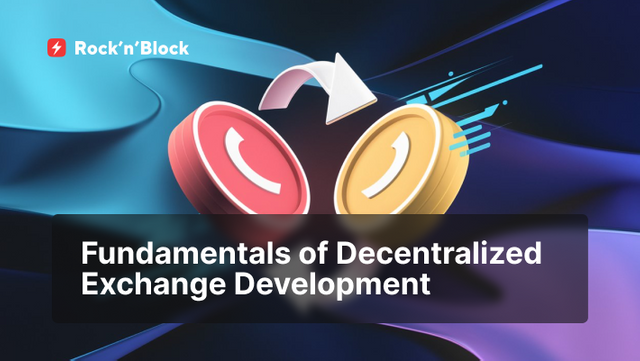Fundamentals of Decentralized Exchange Development in 2024

What is a Decentralized Exchange?
A Decentralized Exchange (DEX) is a platform for peer-to-peer cryptocurrency trading without intermediaries. Unlike traditional exchanges, DEXs operate on blockchain technology, ensuring users retain control of their assets. Smart contracts facilitate transactions, reducing risks of hacks and fraud. This creates a secure, transparent trading environment, attracting more users and investors.
To create a DEX that stands out it is really important to understand the fundamentals of DEX development, use the latest technologies, partner with reputable and skilled developers, and implement core features.
Trading Features in Decentralized Exchange Development
Decentralized exchange development incorporates various trading features to enhance user experience and efficiency:
- Slippage Mitigation: Techniques to minimize price differences due to volatility, using maximum slippage tolerances and advanced algorithms.
- Cross-Asset Trading: Allows users to trade different types of assets seamlessly within the same platform, enhancing liquidity and utility.
- Derivatives Trading: Creation of derivative products like futures and options, allowing users to hedge risks and speculate on prices.
- Multi-Path Trading: Splitting orders across multiple liquidity sources for optimal trade execution.
- Trading APIs: Tools for automated trading and integration with third-party apps, supporting functionalities like order placement and market data retrieval.
- Diverse Order Types: Implementation of various order types (market, limit, stop-loss) to cater to different trading strategies.
Liquidity Management in Decentralized Exchange Development
Effective liquidity management is crucial for the success of DEX development. These features ensure that users can execute trades efficiently and at fair prices, making the platform more attractive to traders and liquidity providers alike.
- Automated Market Maker (AMM): Uses liquidity pools and algorithms to set prices and facilitate continuous trading without a counterparty. Popular AMM protocols include Uniswap and SushiSwap.
- Concentrated Liquidity: Allows liquidity providers to allocate capital within specific price ranges, maximizing efficiency and reducing slippage.
- Impermanent Loss Protection: Mechanisms to mitigate losses due to price fluctuations, such as insurance protocols or dynamic liquidity pool adjustments.
- Dynamic Fee Tiers: Adjust transaction fees based on market conditions and trading volume to optimize liquidity provision.
- Liquidity Mining: A popular incentive mechanism where users earn rewards, usually in the form of the platform's native tokens, for providing liquidity to the exchange.
- Automated Liquidity Management (ALM): ALM systems use advanced algorithms and strategies to optimize liquidity deployment, rebalance assets, and manage risks in real-time.
Smart Contracts in Decentralized Exchange Development
Smart contracts in DEX development ensure secure, automated, and transparent trading processes. Key smart contract development features in decentralized exchanges:
- Gas Optimization: Reducing transaction costs and improving efficiency through optimized code and efficient data structures.
- Pool Factory Contracts: Automating the creation and management of liquidity pools to adhere to platform standards.
- Liquidity Pool Contracts: Governing deposit and withdrawal of assets, trading fee distribution, and asset valuation within pools.
- Swap Contracts: Facilitating direct cryptocurrency exchanges between users with various trading mechanisms like fixed-rate and variable-rate swaps.
- Routing Contracts: Finding the most efficient trade paths across multiple pools and exchanges to minimize slippage and maximize value.
- Farming Contracts: Incentivizing liquidity provision and other activities through rewards distributed in the platform’s native tokens.
User Experience in Decentralized Exchange Development
Enhancing user experience is crucial for successful DEX development. Key considerations include an intuitive user interface for easy navigation and trading, a fees calculator for transparent cost assessment, a customizable dashboard for personalized trading environments, advanced charting tools for market analysis, order book visualization for market transparency, and responsive design to ensure accessibility across all devices.
Frequently Asked Questions (FAQs)
How to Choose a Blockchain for DEX Development?
Choosing the right blockchain for DEX development involves evaluating factors like transaction speed, security, scalability, interoperability, and the development ecosystem. Popular options include DEX development on Ethereum, BNB Chain, and Polygon. Selecting the right blockchain ensures your platform will be efficient, secure, and capable of handling high transaction volumes.
What Are the Challenges in DEX Development?
Challenges in decentralized exchange development include ensuring security, attracting liquidity, creating a user-friendly interface, navigating regulatory compliance, and managing scalability. Each of these aspects requires careful planning and execution. To overcome these challenges, partnering with a robust DEX development company is crucial.
Can I Fork Existing DEXs?
Yes, you can fork existing DEXs, which can save time and resources compared to building DEX from scratch. Forking involves copying the open-source code of an existing DEX and modifying it to meet your specific requirements.
How Do I Ensure the Security of My Decentralized Exchange?
Ensuring security involves conducting smart contract security audits, keeping the platform updated, running bug bounty programs, using multi-signature wallets, and following secure coding practices. These measures help protect against vulnerabilities and hacks, ensuring a safe trading environment.
How Much Does it Cost to Create a DEX?
Crypto exchange development costs vary based on platform complexity and features, typically covering development, design, smart contracts, infrastructure, marketing, and maintenance. Basic decentralized exchange development starts around $40,000, while advanced features and scalability solutions can push costs beyond $500,000.
How Long Does It Take to Develop a DEX?
Developing a DEX typically takes 3 to 12 months, depending on the project's scope, feature complexity, and thoroughness of testing. This timeline includes planning, development, testing, and deployment phases to ensure a functional and secure platform.
Why Choose Rock'n'Block for DEX Development?
Partnering with Rock’n’Block ensures successful DEX development due to our 15+ years of blockchain expertise, delivering over 300 projects. We offer comprehensive services, including smart contract development, perpetual and concentrated liquidity DEX creation, AMM and order book-based DEX development. We provide custom solutions tailored to your needs, prioritize high security with rigorous audits, and have a proven track record of timely, high-quality delivery. Our multi-blockchain expertise spans Avalanche, Ethereum, Polygon, and more, with ongoing support and maintenance to keep your DEX running smoothly. Choose Rock'n'Block for excellence at every project stage!